Since its proposal by SpaceX CEO/CTO Elon Musk in 2013, Hyperloop technology has evolved beyond a futuristic concept into a near-future, new world standard for high-speed transportation efficiency. Hyperloop design consists of a levitating pod traveling at nearly 760 miles per hour through an evacuated steel tube where low pressure minimizes drag forces and contact-less magnetic levitation further diminishes energy loss. As one of thirty international design teams chosen for the Hyperloop Pod Competition, the University of Wisconsin BadgerLoop team includes both STEM and business majors, as well as accomplished academic and industry advisors.
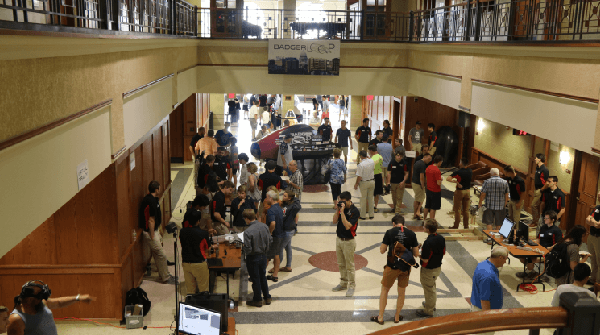
That was one thing that I was always wanting throughout the years. Many companies are going the route of online cloud-based systems and while I understand and agree for the most part in doing this, when it comes to cloud based rendering I haven’t totally bought into it yet. Many times, in business we must make calculated decisions quickly and in order to do that effectively, we need to have all the facts. Most often, these facts are derived from the continual testing of benchmarks and proving which rendering process is better. Again, I completely understand the reasons as to why cloud-based IT systems are great (enhancing storage, redundancy, and accessibility from anywhere), but I just am not there yet with rendering. Based on my experience, unless you’ve really done rendering, it’s hard to understand it and why a physical machine just works better. Most people would think it’s just computing power, but there’s a whole science to it. For the last couple of years, there’s been a challenge between designers, modelers, and IT departments on pushing rendering to the cloud and I think that many of them, especially those that I work with, understand now. That’s probably because I can be a bit of a pitbull with a bone (laughs)!
I recently spoke with a pair of UW undergrads, Technical Director Max Henry and Structural Analysis Team Lead Justin Williams, just two of the one hundred brilliant young minds behind BadgerLoop.
Well through many years of trial and error I’ve done rendering and animation with some machines bought, others built, and tons of software, and it was from those years of “error” I knew what I needed to do and what I didn’t, so it was more a point of proving why people needed to simply trust my decisions.
Justin: I’m a junior majoring in engineering physics, which is kind of an experimental degree, so I study scientific computing. I first heard about BadgerLoop in the summer of 2015. An email was sent to the entire college of engineering asking for people who were interested in this and it reminded me of the project I read about in 2013 when Elon Musk first published his paper. I was so amazed that this was a competition that was actually going to happen! I had been asked to do something that most engineers don’t get a chance to do—to build something like this, something that could actually change transportation. I just thought it was a great opportunity. I began learning as much as I could because no one teaches you how to build high speed pods in classes. I had to learn how to do it, what challenges would be involved, and figure out what I could contribute and what I could improve.
My main role on the team is to go through our entire design and ensure that it won’t fail when we go to the competition in California. I also maintain standards on safety, etc. On a typical day, I finish with all my classwork, then I go into our computer lab area and just start working on simulating everything there is to simulate. That involves using Ansys and doing repetitions and simulations so we find the right result. I also help make sure our design is safe.
Max: I’m a sophomore, and as tech director, I do system integration on the mechanical side of things. We do a lot of CAD for our design—very compute heavy.
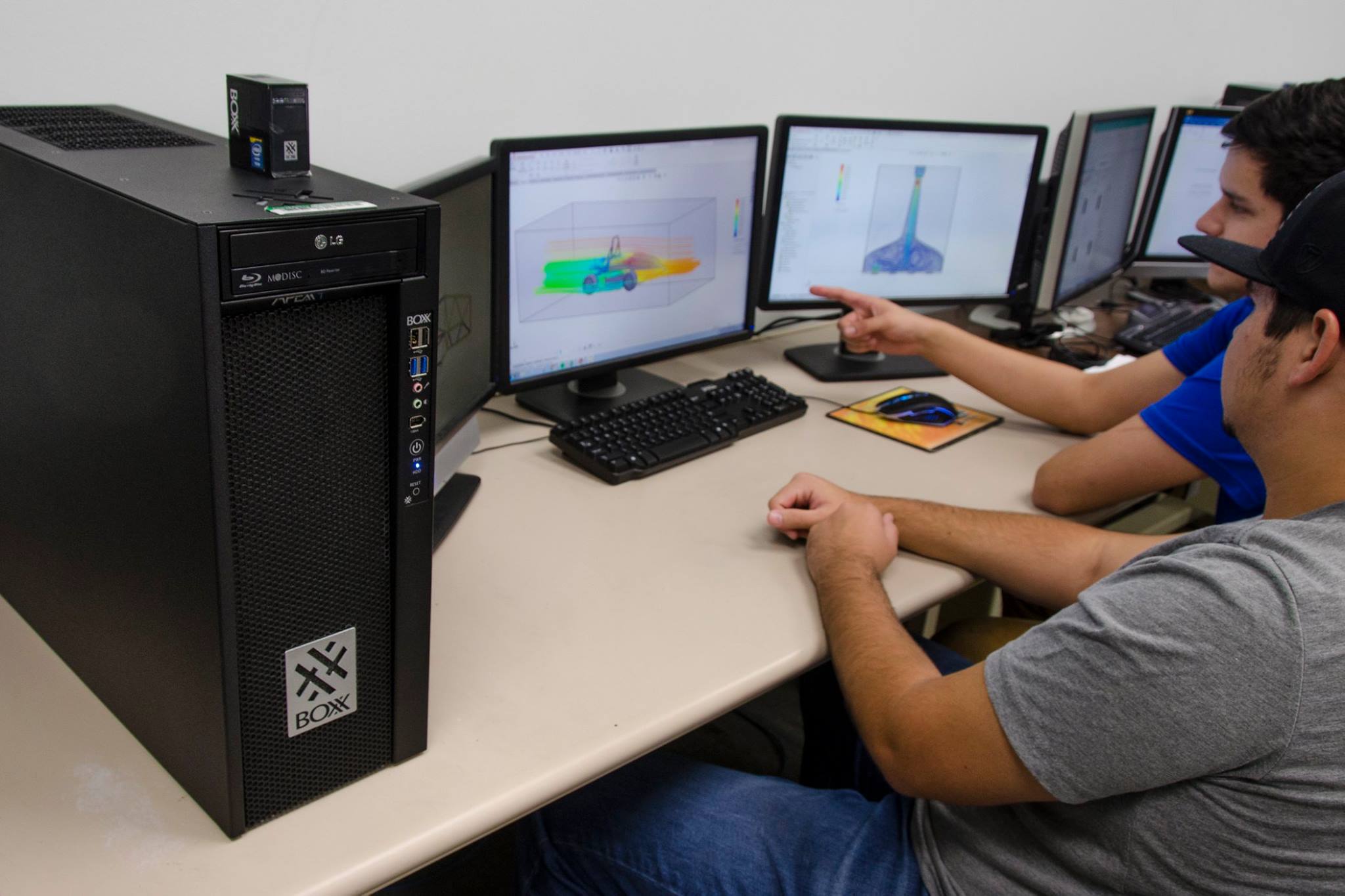
Max: We do all of our design on the computer, so within that design, we go from design to simulation. That’s when we do all of our geometric modeling—using CAD and SOLIDWORKS. After the design parameters are set, we use other computer simulation packages and that’s where we do a lot of our finite element analysis and computational fluid dynamics. It’s also where we validate whether or not our design is going to work. We determine our specs, so if we go with a design that looks like this, how strong is it going to be? We can also run our finite element analysis with Ansys. We plug in the loading scenario and we can see how strong it’s going to be and where the weak points would be if it would happen to fail in a higher loading scenario. After we validate our designs and see our simulations, we go back and do computer drafting where we create drawings. From those drawings, we go into the shop and make the design.
Max: BadgerLoop is split into two halves—one is business and logistics and the other is the actual technical engineering aspects. We are engineering a vehicle, so there are multiple disciplines of engineering. We have mechanical engineers doing physical design, then we also have a lot of electrical and procure engineers who are integrating electronics and software within the pod.
Max: We are almost exclusively undergraduates. There are a couple of graduate students, but the majority are undergrads. We have an academic advisor—UW professor Mike Cheadle. A lot of times, if we have questions, or are going into areas that are a little beyond our skill level, we’ll reach out to the UW faculty here.
Max: Siemens sponsors us with NX, as well as Femap, another finite analysis program. We also use Comsol multiphysics software for magnetics modeling.
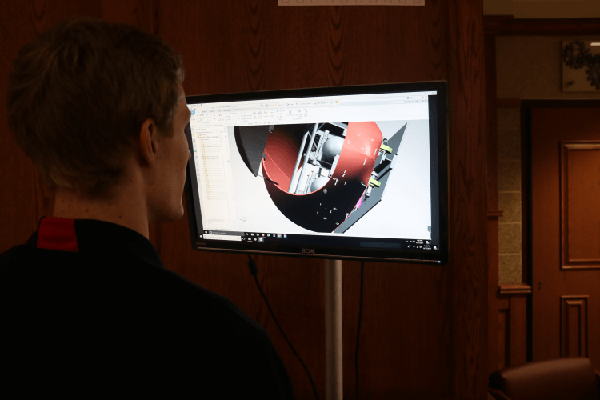
Max: The biggest challenge is the fact that we are undergrads, so it’s difficult to learn a bunch of new software packages. But if we have the tools to do it, then we typically succeed at that.
Justin: Learning the pod typically a year or two ahead of my class, learning all these new techniques, and simulation software. I’d never heard of finite element analysis before BadgerLoop but now it’s all I ever do. Learning these things is always a challenge, but it’s fun rising to the occasion and making cool things.
Max: We have a lot of kids on the team, so sometimes it can be hard to share two BOXX computers. We have additional computers at school, but sometimes they’re not optimized for the level of work were trying to do. A lot of it is for basic stuff –training someone on the basics of a CAD package versus going in depth and doing a full design.
Max: Standard Windows computers provided by the university computer lab. You could say they were a good start, but once you start on the CAD systems and the assemblies become very large, they use a lot more RAM. They would get increasingly slow when we were working and at times, they would crash, which was a pain, especially when you have hours of work put in and you didn’t save it. It was just really hard once you got into the details of doing a more complex design. They’re lower power computers, so they were just becoming increasingly difficult to use.
Max: I believed we talked to a BOXX rep at the design weekend in Texas last January, 2016.
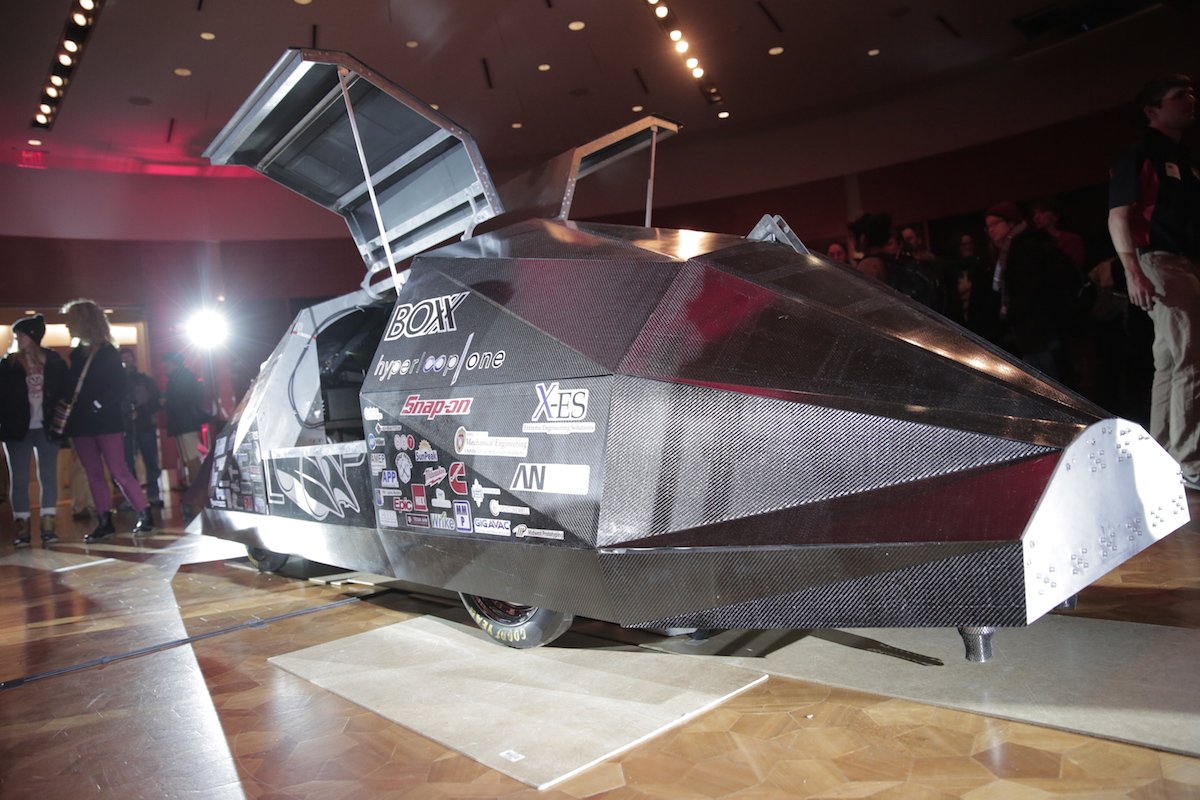
Max: Just the fact that we can run a more sophisticated software. We can go a lot more in depth with our design. We can run better simulations. In the context of a finite analysis or simulation, it’s always nice to know that the computers can handle it.
Justin: It was also a major improvement from the laptops we were using before. When we got the BOXX APEXX workstations, we realized we couldn’t keep doing our simulations on our laptops. They had been taking hours—longer and longer. Once we got the BOXX systems, we all were trying to use them instead, because running simulations on them cut our time down from hours to minutes. When I run a simulation overnight and come back in the morning, it will be running smooth or finished. I don’t have to worry about something going wrong or crashing, which was always an issue with laptops. BOXX improved our workflow.
Max: Oh yeah, and it was nice to not have to wait three minutes to open up our assembly files.
Max: We’ve saved hours and hours —especially during the design crunch. Also, if something turns out wrong down on the shop floor, we can just go back up and not wait minutes for it to open. That’s a really nice convenience.
Max: There were times when it wasn’t rendering. There were times when we had to compromise and tone down our resolution or the detail of the renders.
Max: No—never had to call and we’re using the BOXX workstations a lot. Last year, we used SOLIDWORKS for our CAD, however, this year we switched to Siemens NX which is a little more conducive to a high-powered machine. We really like using BOXX because it supports NX so well.
Justin: (laughing) Yes, I’m pretty protective! It just sort of falls into a hierarchy, so being the lead simulation engineer, I get first dibs. After me, it moves down to the CAD and rendering people who really like using BOXX because rendering images of the pod take a while. The CAD people get it last because they can always use their laptops for modeling small parts. But yeah, there’s always a little competition.
Max: In the beginning, we sent them our design and at the first stage, over 1000 teams applied. We told them we would love to be part of the competition. From there, we had to keep sending SpaceX power points of the design. From there, the competition was whittled down to 100—all universities and a few high school teams. It was narrowed down further to a final 90. Design weekend was in Texas in January of 2016. From those 90 teams, there were about 25 that moved on to California, so within that phase, our team placed third in the design portion. From there, we had to go and build our design. There were a couple of things we ended up tweaking. It was kind of a bummer because the competition ended up being postponed a couple of times. SpaceX ran into a few issues making the tube come to life. We originally planned to be in a competition last summer (after the January design weekend) because we wanted to stay on the schedule of having a competition every summer. After the January competition, they wanted to restart the cycle again. Now we’re on to the second iteration of competition, so we have had to go through the process all over again –hundreds of teams that originally started out and you keep whittling them down to another 30 that will actually go to California. Because of this, we revised our design and got pushed through to California for the next iteration that should be in late August, 2017. We’re all really excited about it.
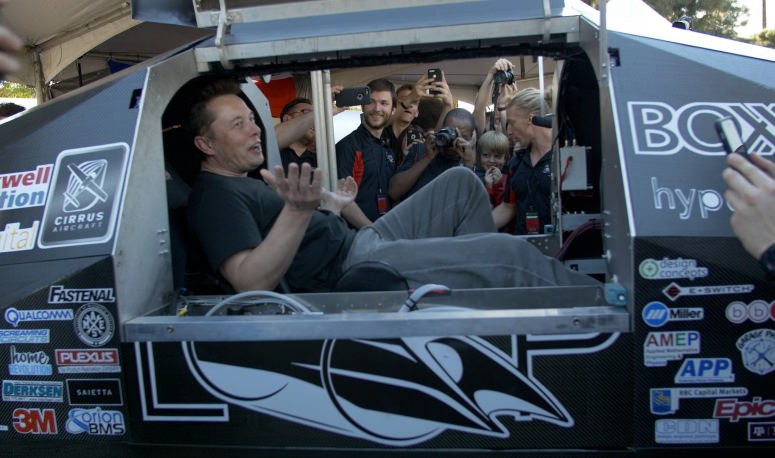
Max: We were the only pod that was big enough to fit a full-size human. It wasn’t a requirement in competition to actually have a payload large enough to fit a human being, but we decided to do that at the beginning of the project because we thought it would be pretty lame to build a vehicle that couldn’t actually carry anything. We kind of figured that that would be our mark on the competition. It was exciting to see him sit in the pod. Apparently, he texted one of the SpaceX advisors the night before, asking to be shown a cool pod. We wondering if he would actually show up, so when he did and sat in our pod, it was very special for us.
Max: With VR, that was one of the features that really made our pod stand out when we were in California for the last competition. It takes a really sophisticated OS, so if we didn’t have a computer like the BOXX APEXX, we actually wouldn’t have been able to run that—not on what UW has here –normal computer lab systems.
Justin: During competition week, we were all going to California and we didn’t have laptops that could actually run VR, so we brought an entire workstation, set this all up for four hours and then we had to take it all down again and take it back with us on a thirty hour drive. It was absolutely insane. When we saw the GoBOXX VR laptops on your website, I said, “This is why these exist—so we don’t have to truck desktops to California and back!”
Max: BadgerLoop is a very innovative project. From year to year, we make a lot of design changes. It’s a very design-heavy project. When you have a design process that leads to simulation, the other drafting software, we have to keep innovating and changing our pod. That’s why we’re so very reliant on our BOXX workstations. It’s important to have those tools available to us so we can work in an efficient manner that gives us the opportunity to succeed.
Max: That’s the balance of what we do. A lot of times, we make the tradeoff for studying or even sleeping. The tricky part is getting people to keep their nose to the grindstone. It’s a big commitment, in addition to school, and if you have to have a couple of late nights just to meet a design report that’s due to SpaceX in a week or two, that can be a bit of an issue. At the end of the day, we think that this is really important to our education and we’re willing to make the sacrifice to make that happen.
Max: If Hyperloop is not taking off, it would be cool to continue to work for SpaceX-type industries. I think that’s a goal that a lot of us share.
Max (laughing): Or Tesla.
Justin: Once I graduate, I’d like to work in the high performance computing area. There are some cool companies doing cool things with cloud-based simulation. I’d like to help out. Working on the BOXX made me change my major. I realized how important it was to have good software, good hardware, and the both of them working together to give you results. I’d want to contribute to that.
Justin (laughing): Oh yeah—that’s going to be high on my list.
Justin: You’ve done a good job of that.
Justin (laughing): There you go! I’d just really like to thank you guys. Without your computers, I don’t think we would have had a shot at producing the high quality designs that SpaceX was expecting. The school equipment just isn’t top notch enough to run our simulation and there’s no way we could have created the designs we’ve done. Thank you guys, thank you a lot.